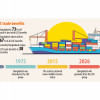Bangladesh's logistics sector needs an overhaul

At a time when Bangladesh is preparing for graduation from the group of Least Developed Countries (LDC) and working towards ensuring sustainable economic growth, high logistics costs are hindering its progress. According to the Dhaka Chamber of Commerce and Industry (DCCI), logistics costs in Bangladesh remain excessively high, estimated at 15 to 20 percent of GDP, far above the global average of 8 to 10 percent. The sector has also been grappling with various challenges including high transport costs, poor infrastructure, and policy gaps, which could jeopardise the country's export ambitions and overall development. Securing long-term financing for logistics infrastructure development has also been a major challenge. Bangladesh, therefore, must improve the performance of this sector to sustain growth and remain competitive in the post-LDC era.
Bangladesh's economic growth is facing significant challenges due to its dependence on the ready-made garment industry and narrow range of export destinations. To safeguard the economy, it is crucial to broaden the variety of export goods and tap into new international markets. Competing globally will also require stronger trade partnerships and more efficient logistics systems. Notably, a 25 percent reduction in logistical expenses could increase exports by 20 percent, as experts say, while even a modest one percent cut in transport costs might lead to a 7.4 percent rise in export levels. Experts have proposed some key reforms—such as digital platforms to connect shippers and transporters, warehouse automation, seamless multimodal transport networks, modernised ports, digital customs solutions, and greener logistical practices—to improve the overall performance of the sector.
Notably, a 25 percent reduction in logistical expenses could increase exports by 20 percent, as experts say, while even a modest one percent cut in transport costs might lead to a 7.4 percent rise in export levels. Experts have proposed some key reforms—such as digital platforms to connect shippers and transporters, warehouse automation, seamless multimodal transport networks, modernised ports, digital customs solutions, and greener logistical practices—to improve the overall performance of the sector.
By 2030, Bangladesh's seaport capacity, including the Matarbari deep seaport, is projected to reach 10 million TEUs (twenty-foot equivalent units). To fully leverage this expanded infrastructure, the private sector must significantly ramp up import and export activities. Achieving this goal requires greater efficiency in the logistics sector as well. Last year, the country introduced its first logistics policy, aimed at reducing costs and delays by streamlining operations across production, storage, transportation, and distribution. The policy also envisioned an integrated cargo transport system connecting all major transport modes. Unfortunately, it remains unimplemented. Revisiting this policy is essential to revitalise the underperforming logistics sector.
Experts have emphasised the need for a 50-year master plan and the establishment of a dedicated logistics ministry or authority. Moreover, constructing a specialised expressway exclusively for trucks and lorries from the Chattogram port to Sitakunda could bring positive outcomes in the transportation of import and export goods. Additionally, securing long-term financing is essential to support the sustainable development of the logistics infrastructure.

 For all latest news, follow The Daily Star's Google News channel.
For all latest news, follow The Daily Star's Google News channel. 








Comments